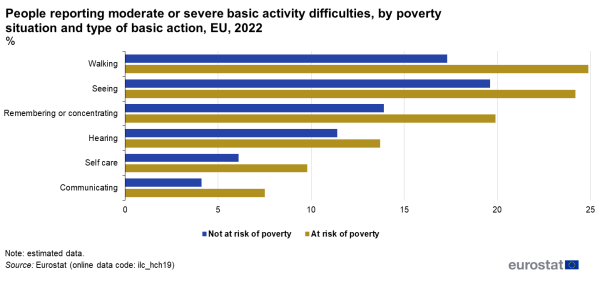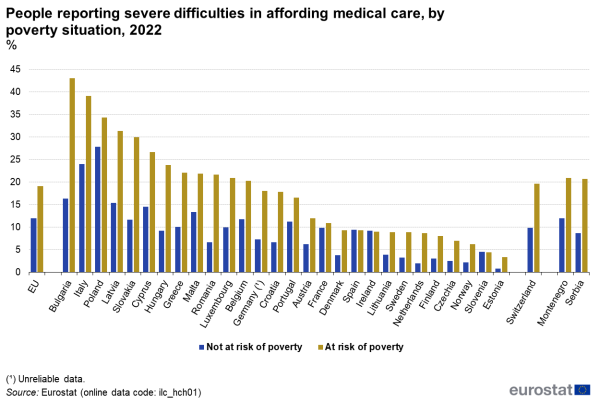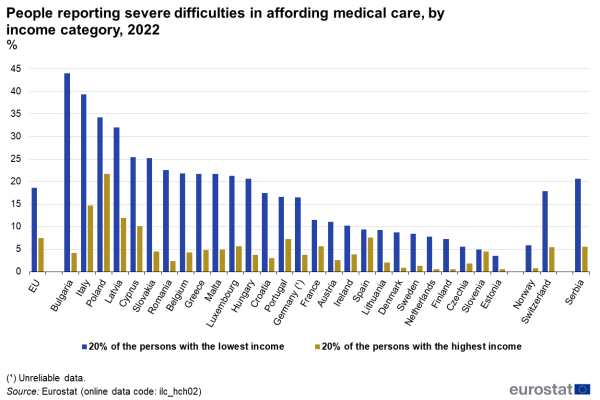Data extracted in January 2024.
Planned article update: March 2026
Highlights
In 2022, almost 25 % of people at risk of poverty in the EU reported moderate or severe difficulty in walking.
In 2022, 19 % of people at risk of poverty in the EU had difficulties in affording medical care.
People reporting severe difficulties in affording medical care, by poverty situation, 2022
In 2022, at EU level, people at risk of poverty (AROP) reported more difficulties both in carrying out basic activities and paying for medical care: 24.9 % had moderate or severe difficulties walking, and 24.2 % had sight related issues. The shares were lower for people not at risk of poverty: 17.3 % and 19.6 % respectively. For healthcare costs, the gap between at-risk-of-poverty and non-at-risk-of-poverty people was around 7 percentage points (pp) with particularly wide gaps in Bulgaria (26.7 pp), Slovakia (18.2 pp) and Latvia (15.9 pp).
This article provides an overview, by level of poverty, of the population in the EU who report difficulties carrying out basic activities. It also looks at how affordability of medical care differs according to a household's economic conditions.
Health problems and financial burden of care
Difficulties with basic activities by level of poverty: largest difference for ‘walking’
Higher shares for the at-risk-of-poverty population can be observed when looking at basic activities (seeing, hearing, walking, remembering or concentrating, communicating and self-care - see Figure 1). Among those not at risk of poverty, at EU level, 17.3 % reported moderate or severe difficulties with 'walking', whereas the figure increased to 24.9 % for people at risk of poverty (a difference of 7.6 pp). Similarly, for 'remembering and concentrating', the respective values were 13.9 % compared with 19.9 % (a difference of 6 pp). For difficulty with 'seeing', the gap was 4.6 pp. Conversely, differences were relatively small for 'hearing' (2.3 pp).

(%)
Source: Eurostat (ilc_hch19)
In the EU, 19 % of people at risk of poverty had difficulties affording medical care
At EU level in 2022, 19.1 % of all people living in at-risk-of-poverty households reported a high financial burden for covering the cost of healthcare compared with 12.0 % in households that were not at risk of poverty (see Figure 2). At EU country level, these shares differed even more, ranging from 43 % in Bulgaria to 3.4 % in Estonia.
The proportion of people not at risk of poverty who reported severe difficulty in paying for medical care varied between 27.8 % in Poland and 0.8 % in Estonia.
Finally, while the difference between at-risk-of-poverty and non-at-risk-of-poverty people reporting difficulties in affording medical care was very high in Bulgaria (26.7 pp), Slovakia (18.2 pp), Latvia (15.9 pp) and Italy (15.1 pp), there was hardly any difference in Spain, Ireland and Slovenia. For these three countries, the share of non-at-risk-of-poverty people is even slightly higher than for at-risk-of-poverty people.

(%)
Source: Eurostat (ilc_hch01)
People in the lowest income group have greater difficulties affording medical care
The picture outlined so far is confirmed when looking at the distribution of population by income quintile. At EU level, in 2022, among the 20 % of people with the lowest income (first quintile group), 18.6 % declared severe difficulties in paying for medical care, while only 7.5% of the 20 % of the people with the highest income (fifth quintile group) reported severe difficulties. (see Figure 3). The same pattern can be seen across countries: the gap between these two income groups was very wide in Bulgaria where 44 % of people in the lowest income group reported severe difficulties, against 4.2 % in the highest income group, a difference of 39.8 percentage points. Large differences (more than 20 pp) were also reported by Italy (24.6 pp), Slovakia (20.7 pp), Romania (20.2 pp) and Latvia (20.1 pp). Conversely, this gap was relatively small in Spain and Slovenia (1.8 pp and 0.4 pp, respectively). Finally, Italy and Poland reported the highest shares of people in the highest income group experiencing severe difficulties in paying for medical care: 14.7 % in Italy and 21.7 % in Poland. At the other end of the spectrum, in 10 EU countries, less than 3 % of people in the highest income group reported severe difficulties, with the lowest values recorded in the Netherlands, Finland and Estonia (under 1 %).

(%)
Source: Eurostat (ilc_hch02)
Source data for tables and graphs
Data sources
The data used in this article are derived from the 2022 EU statistics on income and living conditions (EU-SILC) ad-hoc module on “Health”. The statistical variables used for the presented health difficulties (walking, seeing, hearing, remembering or concentrating, communicating and self-care) were developed by the Washington Group on Disability Statistics. The reference population for the information presented in this article covers private households and their current members residing in the territory of an EU Member State (or non-EU member country) at the time of data collection. People living in institutions are generally excluded from the target population. The data for the EU are population-weighted averages of national data. More information on the exact data collection periods in individual Member States can be found in the EU-SILC metadata file and national quality reports. For Germany, low reliability of data is due to small sample size. For indicators calculated at the EU level, if for any country representing a significant percentage of EU population, there are fewer than 20 observations in a cell or there is a high non-response, the EU value is estimated
Context
Indicators calculated with data from the 2022 EU-SILC module on Health provide information on health care, health determinants, health status and disability. Assessing the population’s health conditions and financial affordability of healthcare is crucial, as it complements the focus on poverty and social exclusion within EU-SILC, providing a comprehensive understanding of overall well-being.
Explore further
Thematic section
Selected datasets
Methodology
External links
- European Commission — Directorate General for Employment, Social Affairs & Inclusion: Indicators' Sub-Group of the Social Protection Committee
- European Commission — Directorate General for Employment, Social Affairs & Inclusion: European employment strategy
- European Commission — Directorate General for Employment, Social Affairs & Inclusion: Employment and social analysis
- European Commission — Directorate-General for Employment, Social Affairs and Inclusion — Work-life balance initiatives
